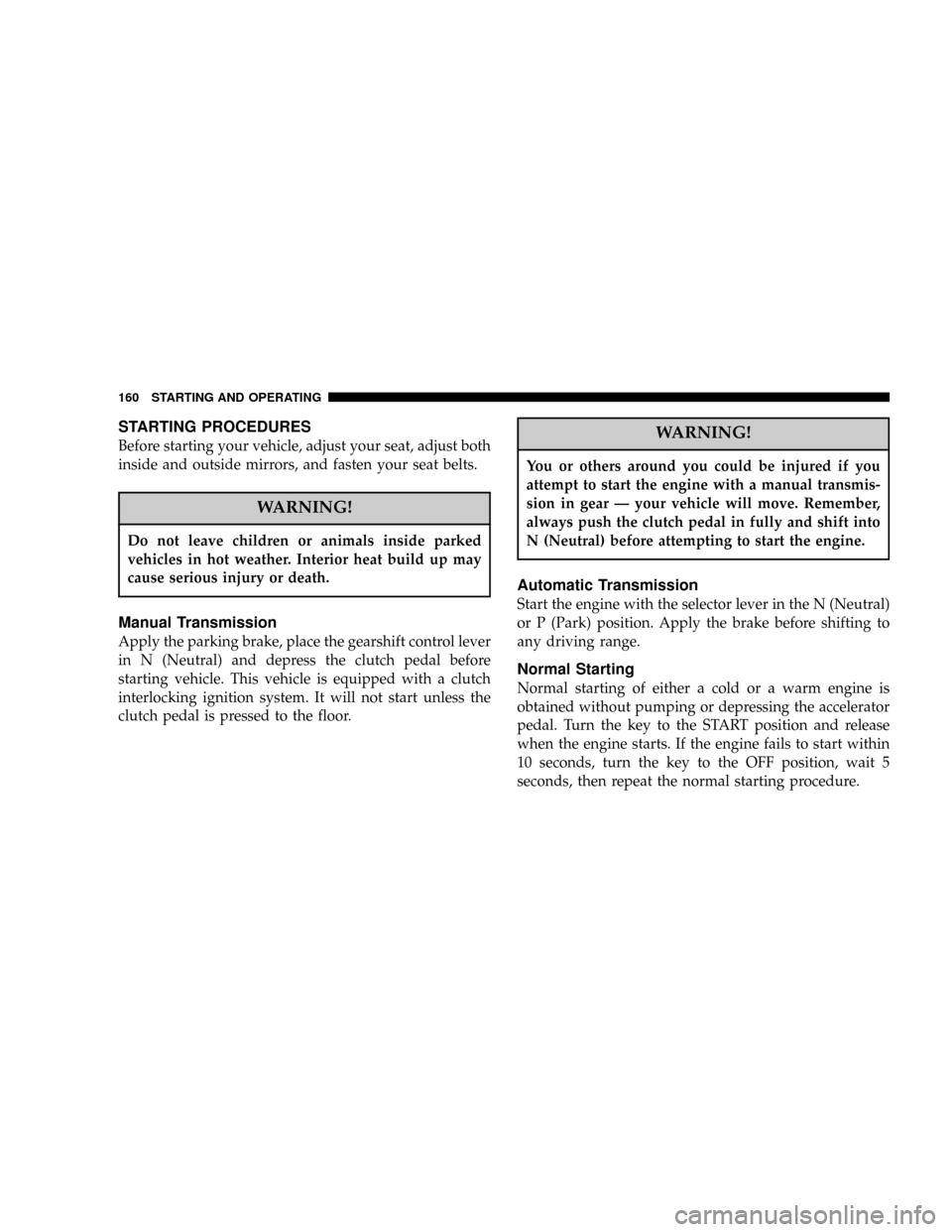JEEP WRANGLER 2004 TJ / 2.G Owners Manual
Manufacturer: JEEP, Model Year: 2004, Model line: WRANGLER, Model: JEEP WRANGLER 2004 TJ / 2.GPages: 299, PDF Size: 6.82 MB
Page 151 of 299

Bi-Level
Air comes from both instrument panel and floor
outlets. Also, a slight amount of airflow may be
noticed at the defrost outlet located at the base of the
windshield.
Floor
Air comes from the floor outlets. Also, a slight
amount of airflow may be noticed at the defrost
outlet located at the base of the windshield.
Mix
Air comes from the floor and defrost outlets with
air being directed through the demisters. This
mode works best in cold or snowy conditions. It
allows you to stay comfortable while keeping the
windshield clear.Defrost
Air comes from the windshield outlets with a
slight amount of air being directed through the
floor and demisters. Use this setting when necessary
to defrost or defog your windshield.
Air Conditioning Ð If Equipped
Blower Switch
The blower switch is the rotary knob to the left of the
controls. Turn the knob to the right to one of the four
positions to obtain the blower speed you desire.
NOTE:The blower motor will run until the system is
turned to the ªOffº (ªOº) position or the ignition is
turned OFF.
UNDERSTANDING YOUR INSTRUMENT PANEL 151
4
Page 152 of 299

Temperature Control
The temperature control is the center knob located on the
climate controls. It controls the temperature of the air
delivered to the passenger compartment.
The ªBlueº area on the left side of the control indicates
cooler temperatures while the ªRedº area indicates
warmer temperatures.
Mode Selection
The mode selector is the right knob located on the climate
controls. It can be set in any of the following positions:
Off
Turning the rotary knob to this position shuts off
the blower motor and outside air will not come
through any outlet.
152 UNDERSTANDING YOUR INSTRUMENT PANEL
Page 153 of 299

Recirculation
Select this position when the outside air con-
tains smoke, odors, high humidity, or if rapid
cooling is desired. This feature allows for recir-
culation of interior air only. Air flows through the
panel outlets in this mode. Also, a slight amount of
airflow may be noticed at the defrost outlet located at
the base of the windshield.
Panel
Outside air flows through the air conditioning
system, and then through the outlets located in
the instrument panel. Also, a slight amount of
airflow may be noticed at the defrost outlet located at
the base of the windshield.
Bi-Level
Outside air flows through the air conditioning
system, and then through the outlets located in
the instrument panel and those located on the floor.
Also, a slight amount of airflow may be noticed at the
defrost outlet located at the base of the windshield.Panel
Outside air comes from the outlets in the instru-
ment panel. Each of these outlets can be individu-
ally adjusted to direct the flow of air. Also, a slight
amount of airflow may be noticed at the defrost outlet
located at the base of the windshield.
Floor
Outside air comes from the floor outlets. Also, a
slight amount of airflow may be noticed at the
defrost outlet located at the base of the windshield.
Mix
Air comes from the floor and defrost outlets. This
mode works best in cold or snowy conditions. It
allows you to stay comfortable while keeping the
windshield clear.
Defrost
Air comes from the windshield outlets with a
small amount being directed through the floor
outlets. Use this setting when necessary to defrost
your windshield.
UNDERSTANDING YOUR INSTRUMENT PANEL 153
4
Page 154 of 299

NOTE:For improved safety, the A/C compressor is
activated when ªMixº or ªDefrostº modes are selected.
This is done to assist in drying the air and it will help in
keeping the windshield from fogging.
Operating Tips
Summer Operation
The engine cooling system in air conditioned vehicles
must be protected with a high-quality antifreeze coolant
to provide proper corrosion protection and to protect
against engine overheating. A 50% solution of ethylene
glycol antifreeze coolant in water is recommended.
Winter Operation
The air from the heater system will heat faster in cold
weather if you use lower blower speeds until the engine
warms up.
REAR WINDOW FEATURES Ð HARD TOP ONLY
Rear Window Defogger
To turn the rear window defogger on, press the
rocker switch. If you press the switch a second
time, you will turn the defogger off. A light on the rocker
switch will indicate the defogger is on.
The defogger will automatically turn off after about ten
minutes. For five more minutes of operation, depress the
top of the switch to turn the defogger on again. To
prevent excessive battery drain use the defogger only
when the engine is operating.
154 UNDERSTANDING YOUR INSTRUMENT PANEL
Page 155 of 299

CAUTION!
Use care when washing the inside of the rear win-
dow to prevent damage to heating elements. Use a
soft cloth and a mild washing solution, wiping
parallel to the heating elements. Also, keep all
objects a safe distance from the window to prevent
damaging the heating elements.
Rear Window Wiper/Washer
To utilize the rear wiper, press the switch to the
first detent. To activate the rear washer, depress the
switch to the second detent. The washer will
continue to spray as long as the switch is held. The switch
will return to the wiper mode when released. To turn the
rear wiper off, lift the bottom of the switch.
Adding Washer Fluid
The fluid reservoir for the windshield washers and the
rear window washer is shared. It is located in the front of
the engine compartment on the passenger side and
should be checked for fluid level at regular intervals. Fill
the reservoir with windshield washer solvent (not radia-
tor antifreeze) and operate the system for a few seconds
to flush out the residual water.
UNDERSTANDING YOUR INSTRUMENT PANEL 155
4
Page 156 of 299

Page 157 of 299

STARTING AND OPERATING
CONTENTS
mStarting Procedures....................160
NManual Transmission..................160
NAutomatic Transmission................160
NNormal Starting......................160
NExtreme Cold Weather
(Below ±20ÉF Or ±29ÉC).................161
NIf Engine Fails To Start.................161
NAfter Starting........................162
mEngine Block Heater Ð If Equipped........162
mTransmission Shifting...................163
N5-Speed Manual Overdrive Transmission.....163
NAutomatic Transmission................165
mFour±Wheel Drive Operation (Command-TracŸ
Or Rock-TracŸ) Ð If Equipped
...........170
NOperating Instructions/Precautions.........170
NShift Positions........................171
NShifting Procedure....................172
mTrac-LokŸ Rear Axle...................173
mAxle Lock (Tru±LokŸ) Ð If Equipped......174
mParking Brake.........................175
mAbout Your Brakes.....................177
mAnti-Lock Brake System Ð If Equipped.....179
mOn-Road Driving Tips..................181
5
Page 158 of 299

mOff-Road Driving Tips..................181
NWhen To Use Low Range...............181
NIn Snow, Mud And Sand................181
NHill Climbing........................182
NTraction Downhill.....................183
NAfter Driving Off-Road.................183
mTire Safety Information..................184
NTire Markings........................184
NTire Identification Number (TIN)..........187
NTire Loading And Tire Pressure...........188
mTires Ð General Information..............191
NTire Pressure.........................191
NTire Inflation Pressures.................192
NHigh Speed Operation.................193
NRadial-Ply Tires......................193NTire Spinning........................193
NTread Wear Indicators..................194
NReplacement Tires.....................194
NAlignment And Balance.................195
mTire Chains...........................196
mTire Rotation Recommendations...........196
mFuel Requirements.....................197
NReformulated Gasoline.................198
NGasoline/Oxygenate Blends..............198
NMMT In Gasoline.....................198
NSulfur In Gasoline.....................199
NMaterials Added To Fuel................199
mFuel Filler Cap (Gas Cap)................200
NLocking Fuel Filler Cap (Gas Cap) Ð
If Equipped.........................202
158 STARTING AND OPERATING
Page 159 of 299

mTrailer Towing........................202
NWarranty Requirements.................203
mSnow Plow...........................205
mRecreational Towing
(Behind Motorhome, Etc.)
................205NShifting Into Neutral (N)................205
NShifting Out Of Neutral (N)..............206
STARTING AND OPERATING 159
5
Page 160 of 299

STARTING PROCEDURES
Before starting your vehicle, adjust your seat, adjust both
inside and outside mirrors, and fasten your seat belts.
WARNING!
Do not leave children or animals inside parked
vehicles in hot weather. Interior heat build up may
cause serious injury or death.
Manual Transmission
Apply the parking brake, place the gearshift control lever
in N (Neutral) and depress the clutch pedal before
starting vehicle. This vehicle is equipped with a clutch
interlocking ignition system. It will not start unless the
clutch pedal is pressed to the floor.
WARNING!
You or others around you could be injured if you
attempt to start the engine with a manual transmis-
sion in gear Ð your vehicle will move. Remember,
always push the clutch pedal in fully and shift into
N (Neutral) before attempting to start the engine.
Automatic Transmission
Start the engine with the selector lever in the N (Neutral)
or P (Park) position. Apply the brake before shifting to
any driving range.
Normal Starting
Normal starting of either a cold or a warm engine is
obtained without pumping or depressing the accelerator
pedal. Turn the key to the START position and release
when the engine starts. If the engine fails to start within
10 seconds, turn the key to the OFF position, wait 5
seconds, then repeat the normal starting procedure.
160 STARTING AND OPERATING